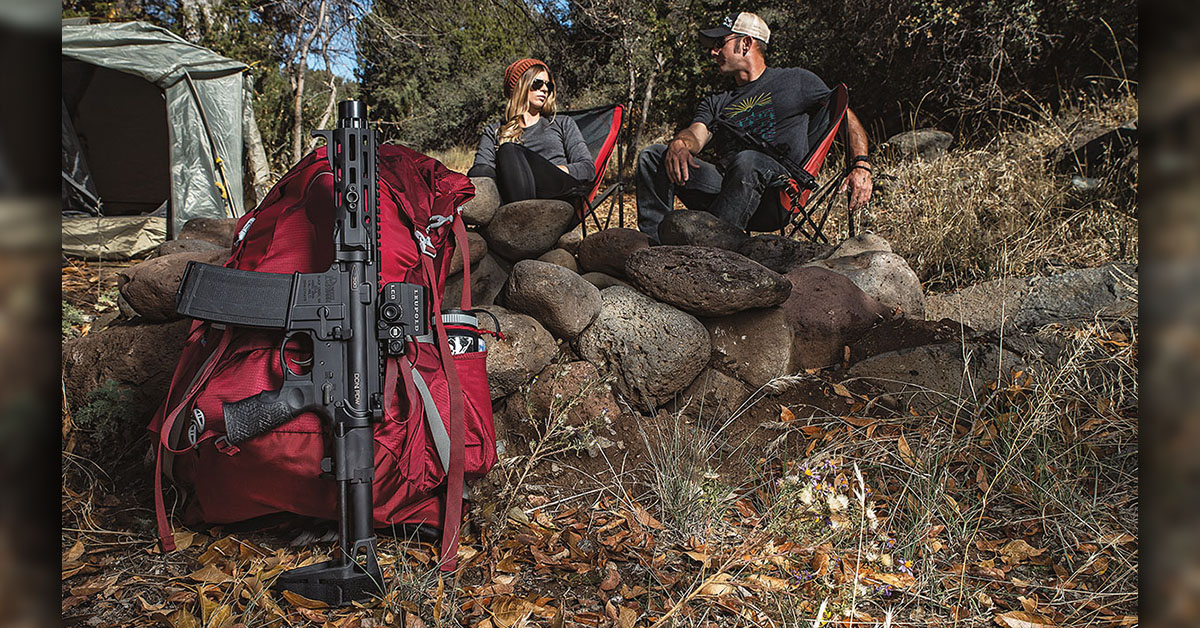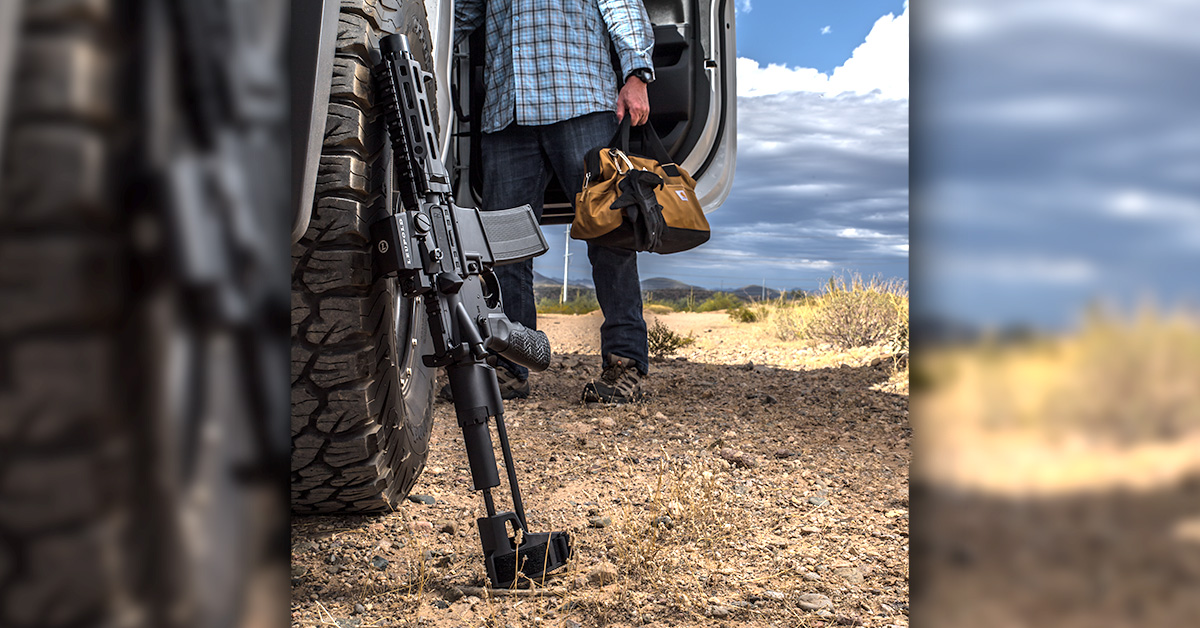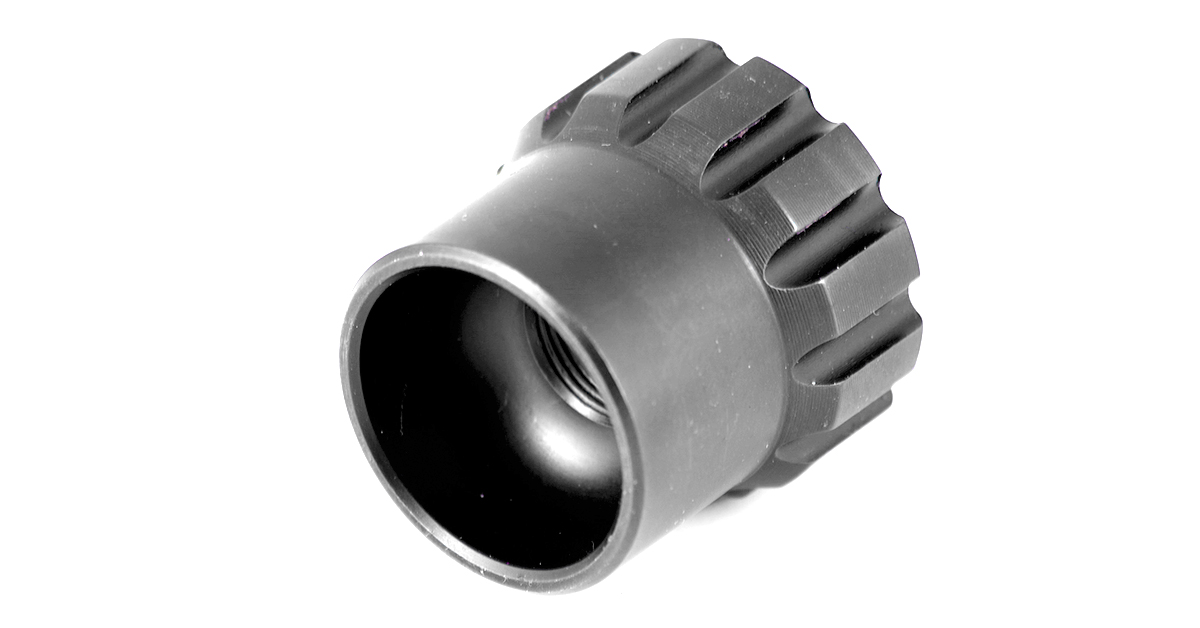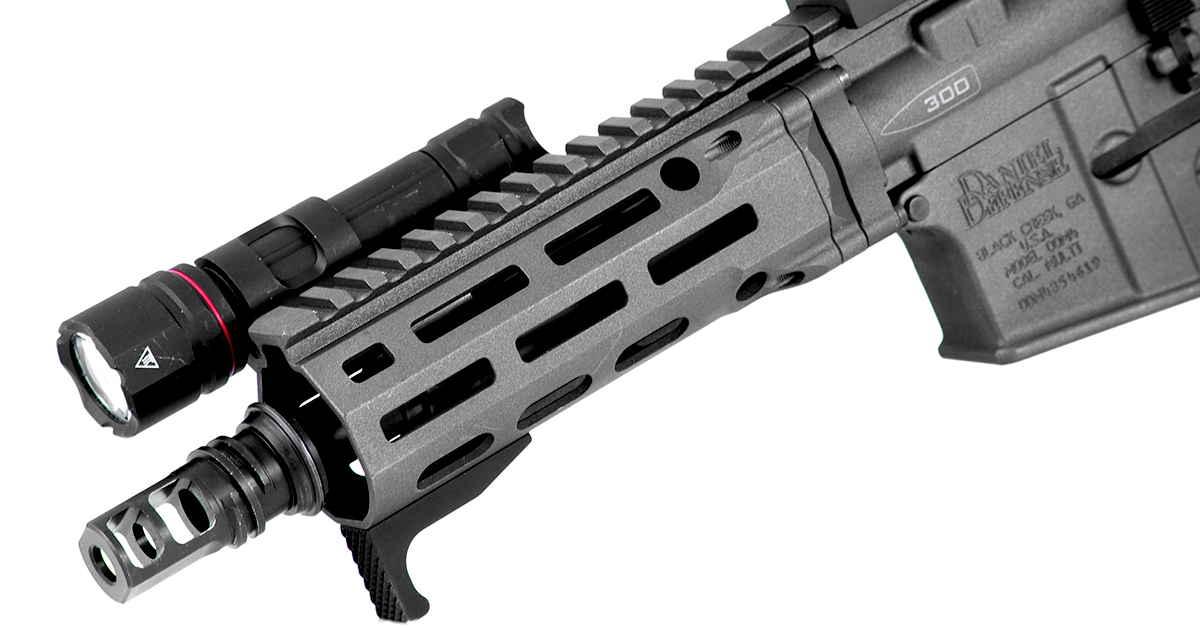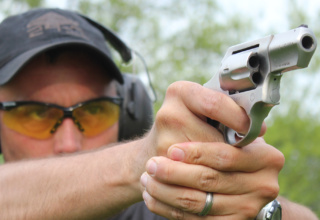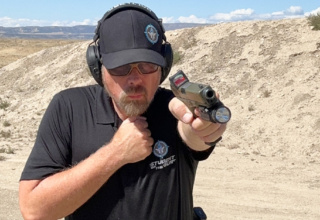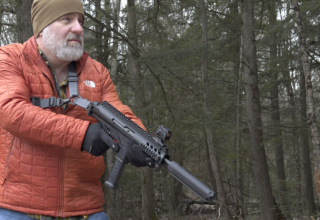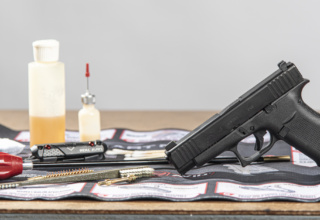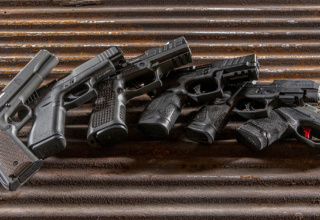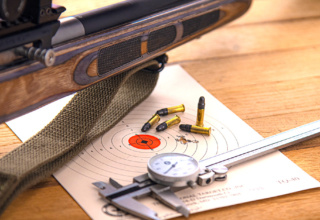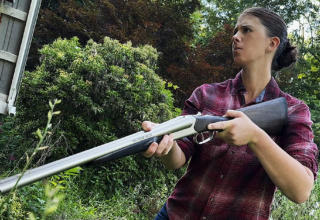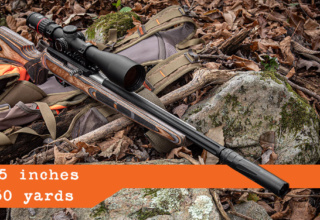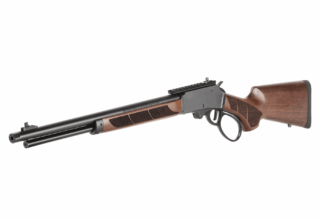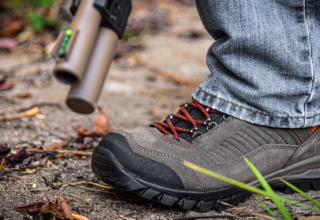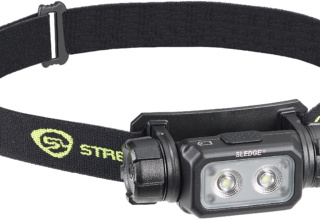A practical guide for new gun owners (and everyone else!) plus a look at the Daniel Defense DDM4 PDW 300 Blackout AR Pistol
by Robb Manning
Never in our country’s history has more people become new gun owners in such a short span of time. Most first-time gun owners purchased their firearm to feel more secure. Times are crazy, and it feels like violence is becoming the norm. When it comes down to it, we all just want to feel safe.
According to those selling guns, the majority of people buying their first gun are choosing either a handgun or an AR style rifle (Fact: Despite popular belief in the media, AR doesn’t stand for Automatic Rifle, it stands for Armalite Rifle).
For the sake of full disclosure, when it comes to handgun versus rifle, I’m a lifelong member of the camp that believes the best use of a handgun is to fight your way to your rifle.
For home defense, my go-to gun is an AR. I do keep a handgun in my bedside night stand safe…to fight my way to my rifle, which is seven strides from my bed, in my closet. Even though I believe an AR is the best choice, I like the maneuverability of a handgun. So, for my AR, I prefer to keep it as small as possible. That is why I’m a big fan of AR “pistols,” as the ATF classifies them (even though the term “pistol” applied to a rifle is nonsensical).
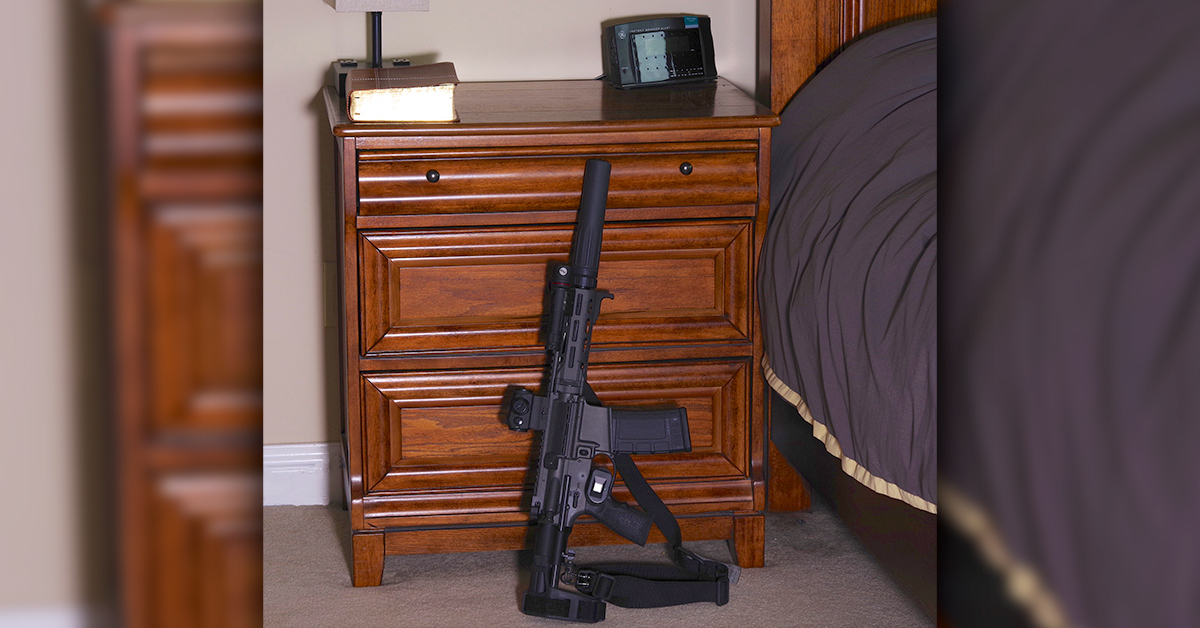
AR Pistols
AR pistols started life as what is called an SBR — the abbreviation for Short Barrel Rifle. The ATF classifies any rifle with a barrel under 16 inches as an SBR. SBRs are great, but they are regulated by the ATF under the National Firearms Act (NFA) just like suppressors. To own one, you must fill out some paperwork — ATF Form 4 — then send it and $200 to the ATF. Then you need to wait several months (sometimes up to eight months) until they send you the tax stamp that says you can own the SBR.
Along the way, an enterprising American realized if you remove the stock, the short barrel rifle can be called a “pistol” and the barrel can be as short as you want it in this configuration. Plus, if you attach an “arm brace” where the stock used to be, you can stabilize the pistol enough to shoot it relatively accurately. The ATF went back and forth on whether it was legal to shoulder the arm brace like you would a rifle with a stock. That issue continues to remain gray, but it is also moot at this point because the Bureau of Alcohol, Tobacco, and Firearms is removing the “stabilizing brace” exemption beginning in August of this year (2022). Once this rule change goes into effect, former AR pistols with stabilizing braces will be deemed short barrel rifles per the BATFE and will require the appropriate NFA tax stamp to be legally possessed. See our recent article on how to legally convert your AR pistol to an SBR for more information on this process.
[Editor’s Note: The way we understand the upcoming rule changes, AR pistols will still be allowed. It’s just that they will be permitted to be owned (without an NFA tax stamp) only if there is no device attached to the buffer tube or able to be attached to the buffer tube, as with the original AR pistols that had a smooth buffer tube with no means to attach a stock.]
I own a couple of SBRs, and I can attest, if the stabilizer brace had been around about 5-10 years earlier, I wouldn’t have bothered with the SBR. In addition to the paperwork and additional cost of the stamp, there’s a little more to owning one. If a gun gets stolen or lost, you must report it to local law enforcement. But if you lose an NFA item, like an SBR, it’s an ATF issue, and they must get involved. So, you don’t want to just store your SBR in your truck and leave it there. Movement is also regulated for NFA items. If you’re going on vacation and want to take your SBR, you’re supposed to notify the ATF. You don’t have to do any of this for an AR pistol.
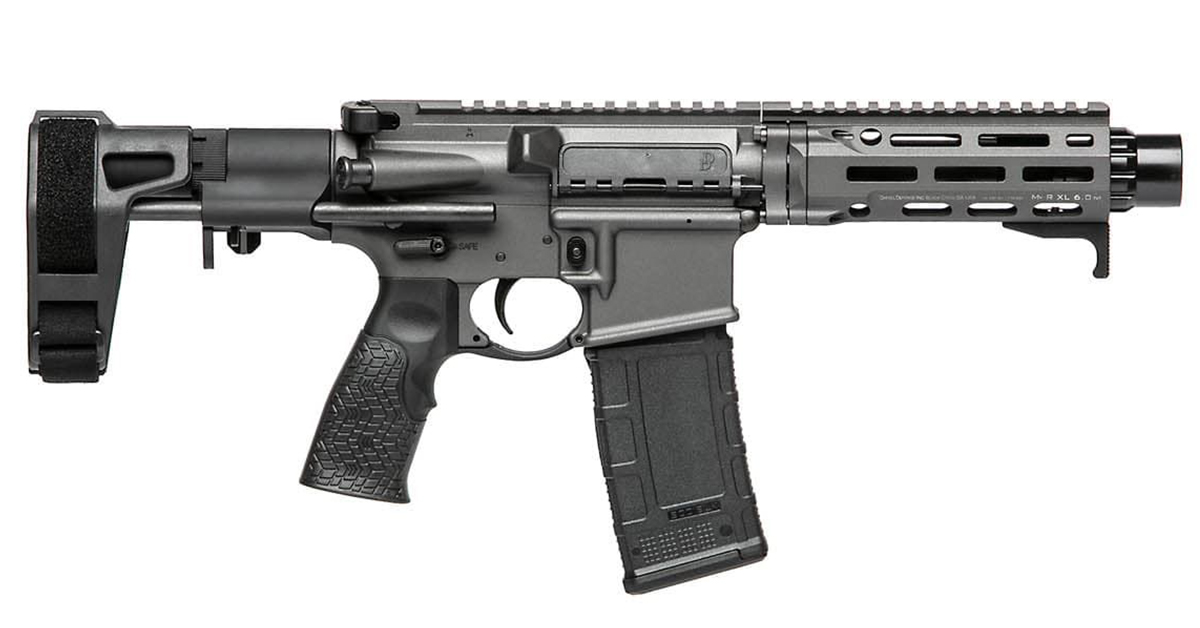
The AR pistol is as close as there is to the perfect home defense gun, in my mind. It’s small and light for easy maneuverability inside the home and for stowing inside your backpack for hiking or camping. But it’s chambered in a rifle cartridge. More importantly, though, ARs are extremely reliable, and very safe to operate. Plus, controls are intuitive — a big plus for new shooters. For most new shooters, you show them once how to operate the controls and you never have to show them again. There are no odd levers to press, awkward safeties to negotiate, or magazines to rock.
Caliber
The AR comes chambered in numerous calibers, but since we’re talking about AR pistols, the choices pretty much comes down to 5.56mm/.223 or 300 BLK (abbreviation for 300 AAC Blackout). Most people are familiar with 5.56/.233 ARs — those are most common, and ammo is usually the easiest to find. The 300 BLK is also very popular and has many ammunition choices. I’m perfectly fine with choosing the 5.56 for home and/or personal defense, but for my setup, I prefer the 300 BLK.
The 300 BLK was developed to be shot out of a short-barrel AR and with CQB (close quarters combat) in mind, which, for all intents and purposes, home defense is not unlike CQB. Plus, I don’t really want something that is high velocity and shoots really far. I live in the suburbs and must be conscious of collateral damage. Another reason (I’ll explain why later in this article) for home defense is that I prefer subsonic rounds, and 300 BLK has the most subsonic choices of pretty much any rifle caliber. Most 300 BLK ammo is subsonic if it has a bullet weight around 200 grains or more (I’ve seen as low as 190 grains).
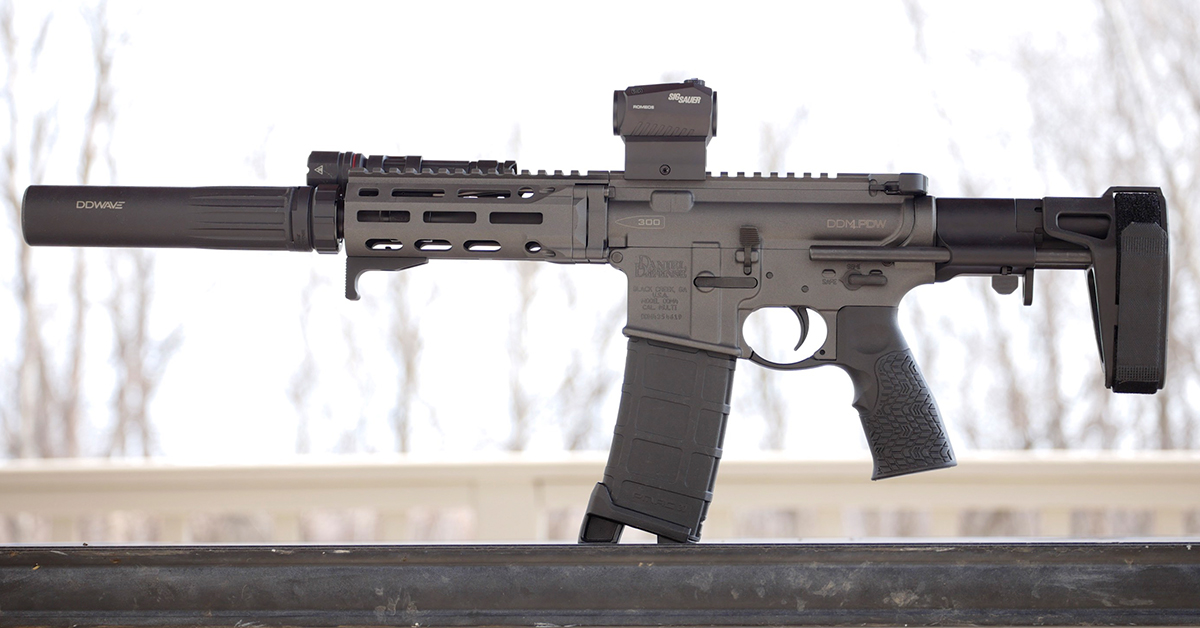
The 300 BLK offers the most versatility in an AR pistol. I was not a big fan of the 300 BLK for a long time, but it has slowly won me over. Not only is it an excellent choice for home defense, but it’s also a great choice for most personal defense situations that a civilian can find themselves in. The 300 BLK is excellent at retaining energy out to 300 yards, even when fired out of a 10.5-inch barrel. Short barrels are, in part, what the 300 BLK was designed for. Of course, at that distance accuracy suffers — it’s meant to be a short- to mid-distance round. As a comparison, the bullet drop at 300 yards for 5.56 is measured in inches; for the 300 BLK, it can be measured in feet.
An AR pistol in 300 BLK makes an excellent truck gun. I’m never looking for trouble, and the best-case scenario in a vehicle, if trouble finds you, just leave. Get out of Dodge. But if events in the last few years have taught us anything, protests can quickly turn to unrest and riots, and one wrong turn down the wrong street and you can find yourself blocked by a tire barricade that’s on fire and dozens of people jumping up and down on your vehicle trying to get in. I have a wife and kids to protect, and when the gas pedal won’t get you to safety, that’s where the truck gun comes in.
I have a little land up in the Wisconsin Northwoods, and my trail-cam has recorded 13 different bears on the property. Two of those were different mama bears with sets of three and four cubs. Suffice to say, I don’t go anywhere on my property without my AR pistol in my ATV. For all the same reasons, an AR pistol also makes an excellent backpack gun for camping and hiking.
What makes the 300 BLK so versatile is the vastly different loads for it. You can choose full rifle velocity for outdoors and when you want more distance, or you can choose near-Hollywood-quiet with subsonic loads for when you’re indoors. If you have a good AR pistol, it will most likely shoot either one reliably without making any adjustments other than swapping out the mag.
Set-Up/Accessories
I want my home and personal defense AR to be light and agile, so I don’t like a lot of attachments hanging off it. It defeats the purpose of an AR pistol or an SBR if you’re going to attach five pounds of accessories to it. I keep it simple: a compact light, a simple sling, and a compact red-dot optic. Don’t worry about what the tacti-cool crowd is using. Find out what works for you.
For the optic, it’s best to keep it simple — something that is quick to acquire and small so it doesn’t block your view. A red-dot or reflex sight are perfect. It doesn’t have to be fancy, just reliable and rugged. If it uses batteries to power the reticle, make sure the batteries are long-lasting. Models that are motion activated are a bonus because you don’t have to fiddle with turning it on when you need it. They go to sleep when stationary for so many minutes, but automatically turn on when the rifle is picked up. Some call them “shake to wake” sights. I don’t recommend solar charged optics since the rifle will most likely be stored in the dark.
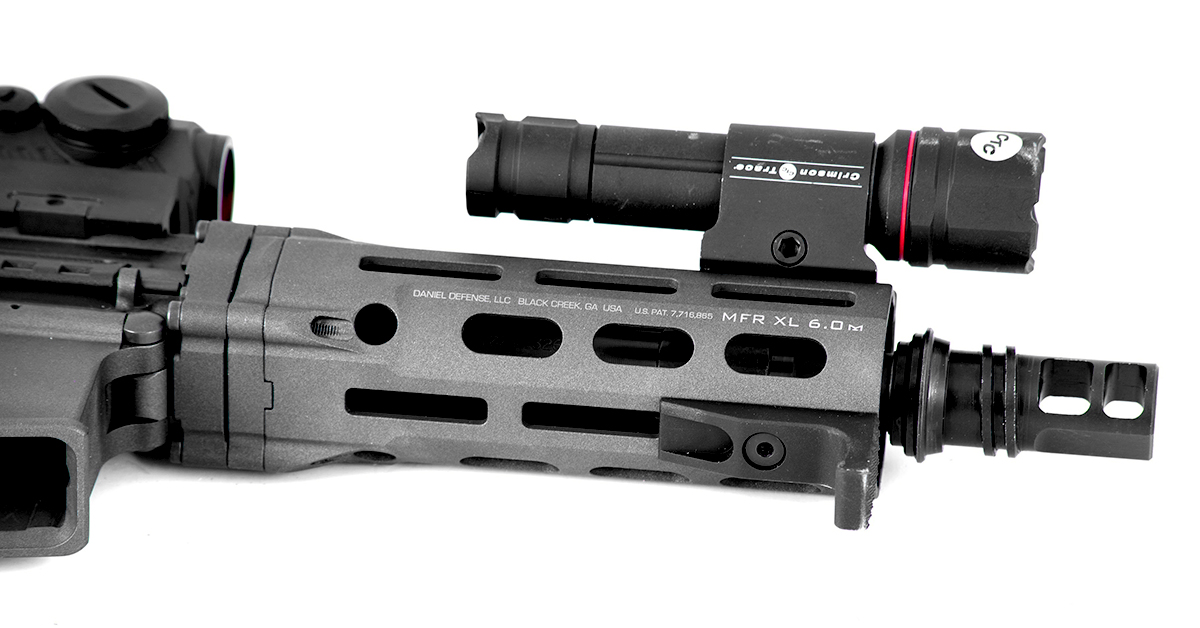
For the light, again, compact and lightweight is important. Brightness isn’t a huge factor when shopping — any LED weapon light will be bright enough to light up a room or for use outdoors.
Another option is a laser sight. Lasers are good for situations where you are shooting from an awkward position and can’t aim using the iron sights or can’t look through the optic. Or perhaps your vision has been impaired due to injury and you have confirmed your target but can’t see well enough to aim — just place the laser dot on the target. Just remember, lasers go both ways, and the beam can be followed back to your position. If I mount a laser on a rifle, this is an example of where smaller is better. I have no problem taking a micro laser designed to be mounted to a handgun accessory rail and mounting it to a rifle’s front handguard bottom or side rail.
One accessory I prefer on all my home defense weapons is a suppressor. I value my hearing, and the hearing of my family, and if you’ve ever fired a gun in a confined space, you know it’s not like it is in the movies. In the movies, people shoot inside houses and even in cars, and there’s no adverse side effects. Afterwards, everyone is talking to each other as if the gunfire never happened. In reality, everyone’s ears would be ringing and most likely in pain. Any discussion would be in the form of yelling. A suppressor protects the hearing of you and your family.

An added benefit to a suppressor is it eliminates muzzle flash. An AR with a short barrel has a lot of muzzle flash since there’s less time for the powder to burn before the bullet exits the muzzle. When the burning powder exits the muzzle, it’s in the form of a high-temperature, high-pressure gas, and when it mixes with ambient air, it produces muzzle flash. If you’ve ever shot an AR with a short barrel at night or in dimly lit conditions, you know it’s not so much muzzle flash as it is a flame thrower. It leaves you seeing spots for a while afterwards. A suppressor captures these gases internally and contains them.
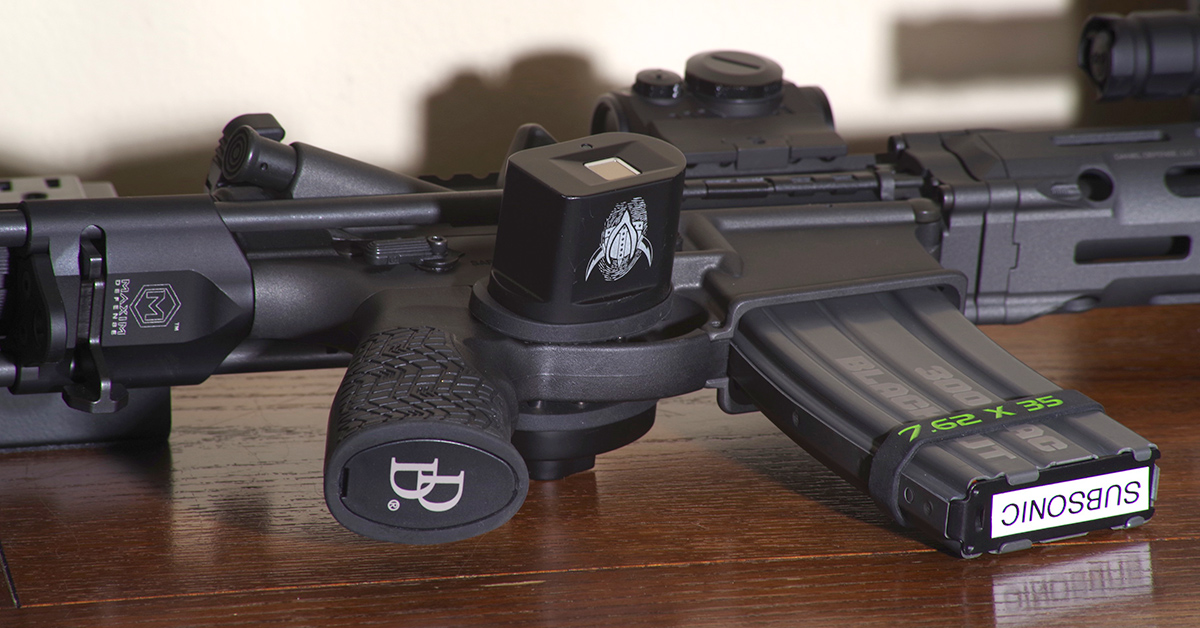
Another accessory you don’t want to forget is spare magazines and something to carry them in. It doesn’t have to be fancy or expensive, just something you can carry hands-free. I have a pouch that holds four mags and has a shoulder strap that I can carry cross-body. It takes about one second to put my arm and head through it. Make sure to clearly mark your magazines as to the caliber, especially if you own multiple ARs of various calibers. The 5.56 and 300 BLK use the same size case, and if they get mixed up in the wrong rifle, the results can be catastrophic and deadly. I like a rubber band marked with the caliber for visual and tactile confirmation in low light. I also label mags loaded with subsonic rounds.
One last accessory is an important one, especially if you have kids around: secure storage. If I need my AR in the middle of the night, I want to have it ready to go, so I have a magazine inserted and the chamber empty. But I’m a huge advocate of securing firearms, so to keep it secured, I have a biometric trigger lock from Viking Trigger Lock — it completely covers the trigger guard, preventing access to the trigger. To remove the lock, just press your trigger finger to the sensor, and if it’s a match, the trigger guard falls away. The lock is rechargeable and they say the charge lasts about 4-5 months, but it should be charged every three months. It’s forgiving of how you place your finger on the pad, and when placed properly, I’ve never had an error — it always opens.
The Final Piece
An oft overlooked piece to home defense is planning. It’s smart to do a physical walkthrough and go over in your mind how you would react to different scenarios. The more contingencies you can plan for, the better. Taking notes isn’t a bad idea, either. Ask yourself what you will do for one intruder, two intruders, and so on. What you will do if they split up or stay together.
Something that is very, very important is figuring out in advance what your sectors of fire are from different locations in the house. Stand just outside your bedroom doorway and map out in your mind where the bedrooms of your family members are. I live in a two-story house, and all bedrooms are on the second floor except the guest bedroom located in the basement. Straight ahead of me is the stairway from the first floor. From my 1 o’clock to my 3 o’clock is one kid’s bedroom, and to my 10 o’clock to my 7 o’clock are the other two kid’s rooms. I know my sector of fire is 10 to 1 o’clock. So, I look for physical right and left limit stops. At the top of my stairs are two banisters with end caps on them, and as it so happens, they align almost perfectly with my 10 and 1 o’clock limits. So, I know that I can never move my muzzle past those points or I could endanger a family member.
From my bedroom, if I take one step forward, I overlook the first-floor family room, so from my 3 o’clock (as I was initially looking straight out from my bedroom door) to 5 o’clock I have a second sector of fire; however, I must take into account that in the basement directly below the family room is another TV area, and this is where my kids watch TV and play video games. But I know that they are never there during the night.
When determining your sectors of fire, make sure to take into account what’s outside the walls of your house. Depending on the type of bullet that you use, most will go through several layers of sheet rock. Which means there’s a high likelihood it could exit your house.
If you don’t have anyone outside of your room to protect, it’s best just to stay in your room and get behind something, like your bed. You should still do a mental assessment of your sector of fire, including no-fire zones, but it will be much simpler.
Remember a couple of paragraphs ago when I mentioned the basement and my kids, and said, “But I know that they are never there during the night.” This brings me to another very important part of planning: discuss your plan with your family and/or anyone living in your house. Have a specific course of action for each person, tell them what it is, and quiz them periodically. For some examples, if my kids hear gunfire in the house, one of them has a bed in the middle of the room, so he knows to roll off the bed to the side away from the door, lay down, and stay put. The other two have beds against the wall, and one has a bunk above his desk. He knows to climb down his ladder, turn to his right, hide behind the headboard and stay put. The other one rolls out of bed, climbs under it, rolls against the wall, and stays put. The key is for all of them to stay put and not run about. I tell them to listen for my voice if I’m giving them any other instruction.
The only other person in my house is my wife, and she knows if I roll out of bed to get the gun, she should call 911. I also account for the location my early warning system. I have two dogs, though I’m pretty sure I’ll know their location, as they’re quite loud, especially if someone were to enter my home.
In Sum
To me, the AR pistol makes for the perfect home and personal defense gun. It blends the portability of a handgun with the full power of a rifle cartridge. The 300 BLK cartridge adds even more versatility because you can choose near-Hollywood quiet with subsonic loads or full rifle velocity with supersonic loads.
But everyone’s situation is different, so what works for me might not work for you. Some people might not want an all-in-one AR for home defense and personal defense when away from home, so they might opt for a full-size rifle for home defense. That’s the beauty of the AR — it comes in an endless array of configurations and options.
The one thing that isn’t optional is planning and training. Do it.
Daniel Defense DDM4 PDW Pistol
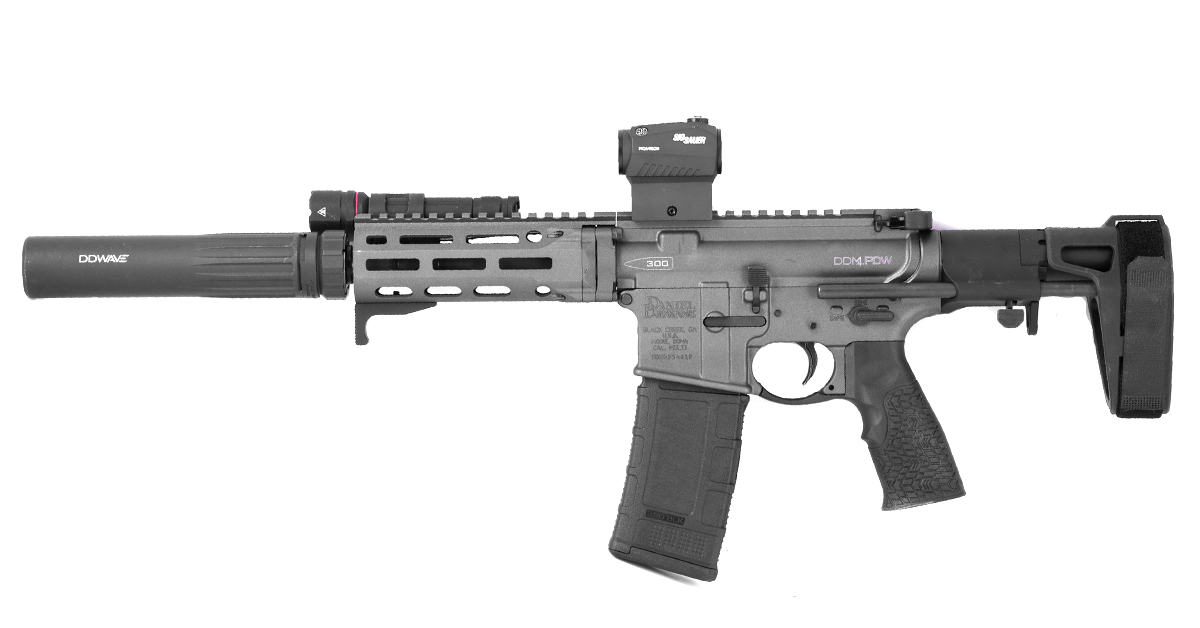
I own a couple of AR pistols that I use in different capacities, but right now my favorite is the Daniel Defense PDW Pistol chambered in 300 BLK. It’s not cheap (it has an MSRP of just north of $2200) but it comes with an impressive array of upgrades that make it more than worth it — especially if you’re someone who plans on upgrading your AR anyway. One of the key upgrades included is the Maxim Defense CQB Pistol Brace and enhanced buffer system, and if bought separate, that alone is $400.
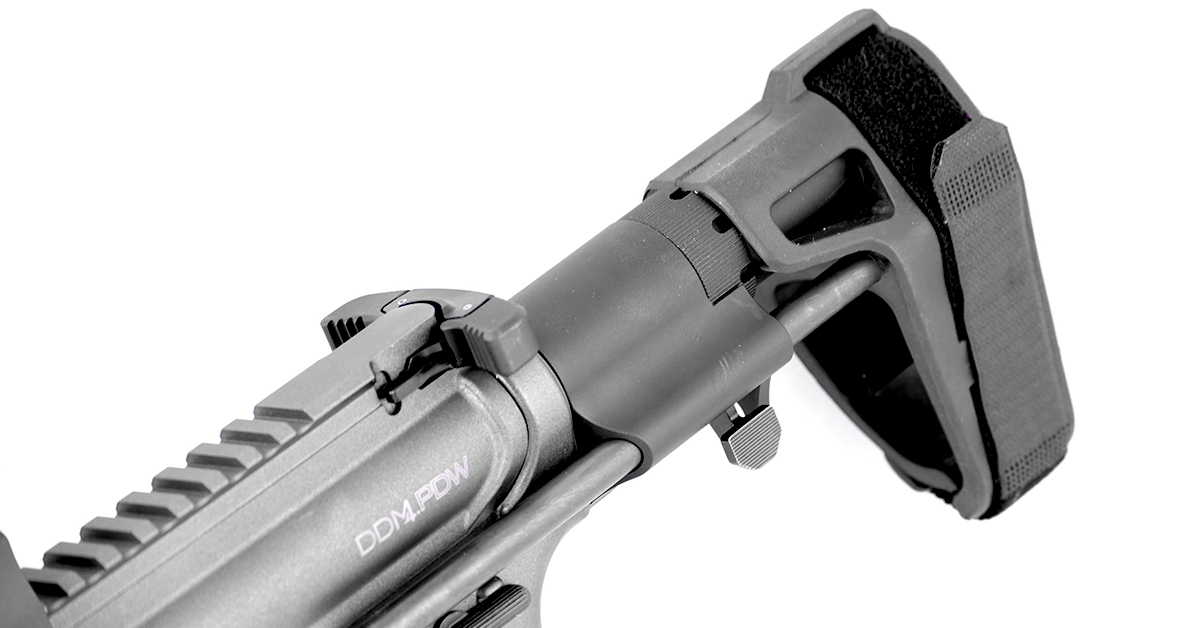
I’ve been a fan of Maxim Defense collapsible stocks and pistol braces for years. They collapse or extend with one button and securely lock in place to provide a stable point of contact. The seven-inch barrel with the Maxim Defense pistol brace makes it one of the shortest direct impingement ARs on the market, measuring 20.75 inches collapsed and 24.75 inches extended.
The DDM4 PDW comes equipped with a linear compensator that’s designed to direct the muzzle blast forward and away from the shooter. It’s very effective, and if you’ve ever fired an AR with a barrel this small or stood next to someone who is, you know why it’s needed. The muzzle thread is standard 5/8×24, so if you want to swap it out for another muzzle device, you can. I wanted a suppressor attached, so I replaced it with the DD WAVE compensator, which allows for quick detachment/attachment of the WAVE suppressor.
It also comes furnished with a proprietary free-float handguard system with a rail along the top and M-LOK attachment along the sides and bottom. At 5.5 inches long, real estate for accessories is at a premium. The handguard system attaches via four bolts and is rock solid. Daniel Defense includes a Barricade Mod2 hand stop from SLR Rifleworks. For me, a hand stop is pretty much mandatory on a barrel this short, for safety reasons. The pistol grip is very comfortable and a has non-slip rubber overmold for a secure grip.
Other features include an ambidextrous safety switch, ambidextrous Grip-N-Rip charging handle, and a flared magazine well.
The trigger is single-stage MILSPEC-ish with a pull weight of 7.15 pounds averaged from 10 pulls with a Timney trigger scale. Some will find it a little heavy, but for a rifle designed for fighting, I’m fine with it. Unlike the government triggers I cut my teeth on, this one is very smooth, with a clean break and not at all gritty.
The pistol comes with a 7-inch, cold-hammer forged, chrome-lined barrel, and the 300 BLK chambering gets all that it can out of those seven inches. It’s more accurate than one would think a short barrel could be. I focused on shooting at 50 yards, which most home or self-defense scenarios will be at or closer than (a bear can close 60 yards in less than three seconds) but extended out to 100 yards to see what it could do.
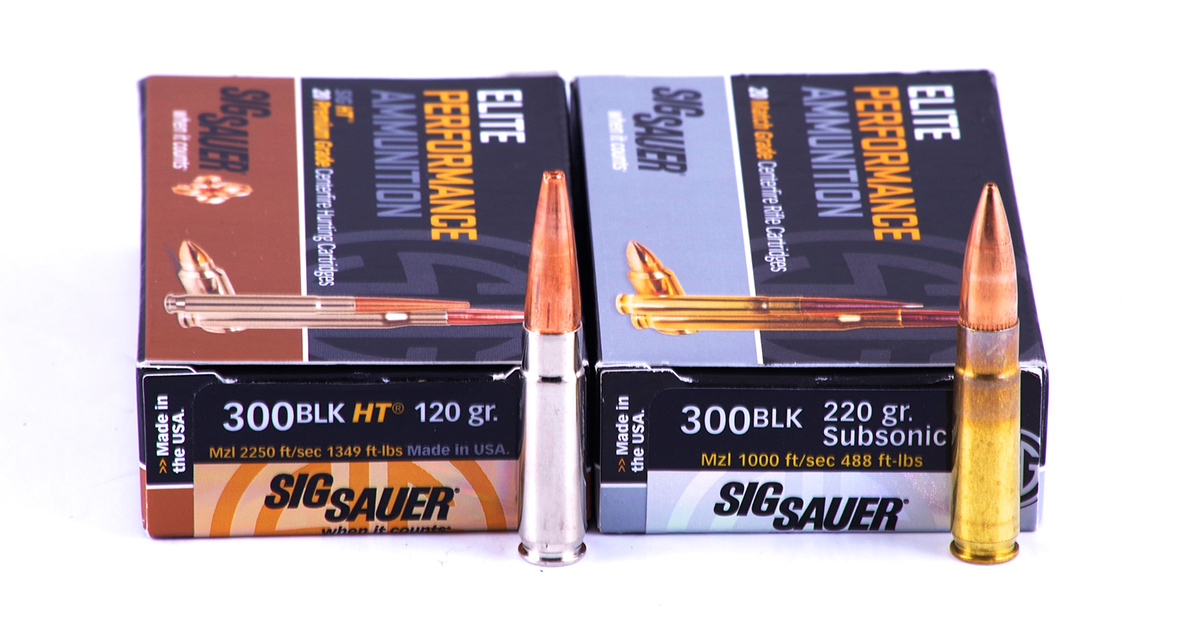
Due to lean times in the ammo department, I only had two loads to test. Both were SIG Sauer Elite Performance Ammunition. One was the 300 BLK HT 120-grain hunting load and the other was the 300 BLK 220-grain subsonic load. I used a SIG Sauer Romeo5 red dot (2 MOA reticle) with a DD WAVE suppressor attached.
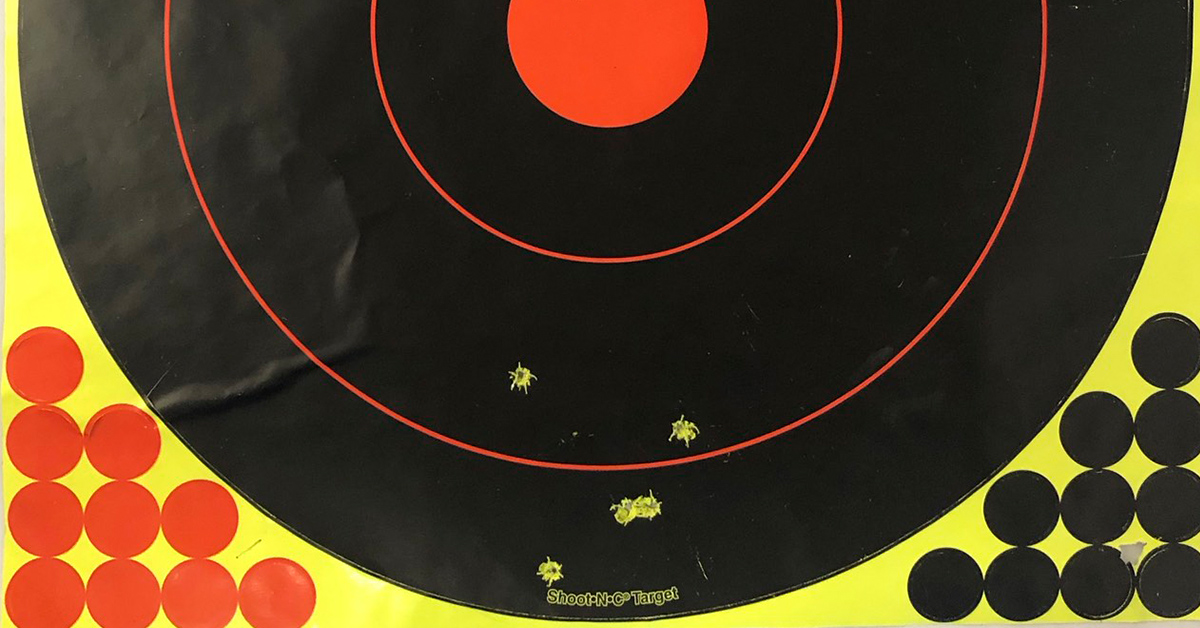
The best groups for the 220 grain Subsonic were 1.68 inch (50 yards) and 2.82 inches (100 yards). For the HT 120-grain it was 3.28 inches (50 yards) and 5.78 inches (100 yards).
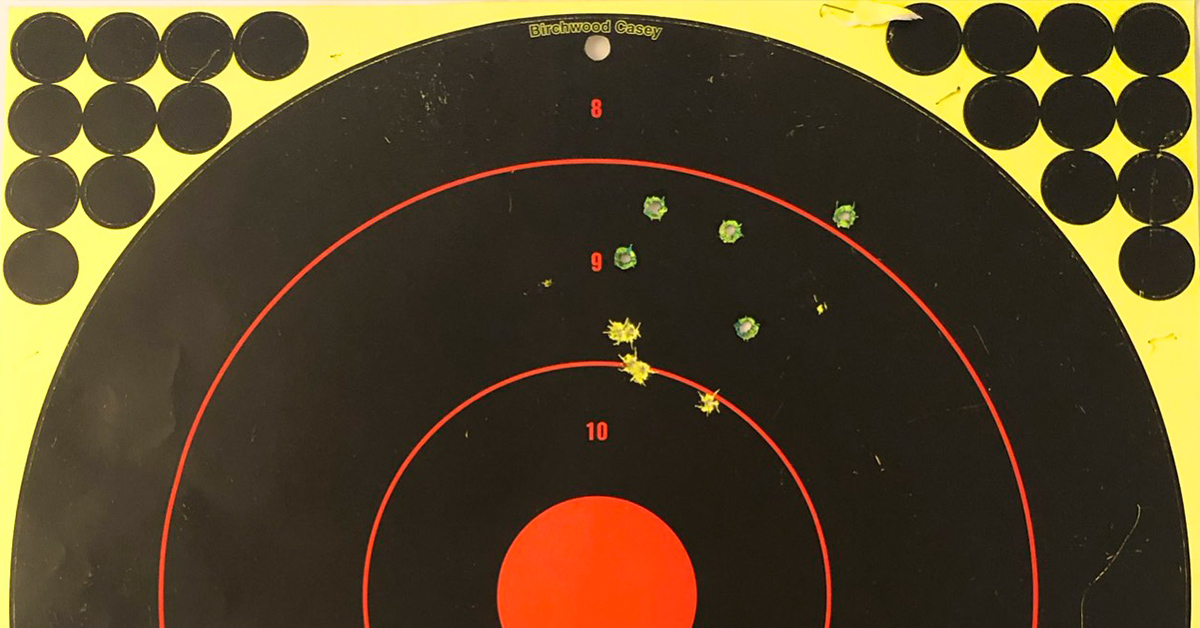
The DDM4 PDW Pistol is very reliable, as an AR should be. At the range, I swapped between 120-grain loads and 220-grain subsonic, and I fired them both with suppressor and without, using the Linear Compensator it shipped with. It didn’t even think about having a hiccup. To further test reliability, I loaded a mag, alternating the two loads every other round and, firing with suppressor, it chewed them up, spit them out, and asked for more. I did enjoy the puzzled looks on the faces of other range goers as they tried to figure out what was going on with my rifle: BANG! pew, BANG!, pew, BANG!, pew…
Not only was the DDM4 PDW Pistol reliable, but I had zero blowback. Granted, it was neither rapid nor high volume shooting, but that’s still pretty impressive. The Grip-N-Rip charging handle has an anti-gas feature, which is a factor. If you’re unfamiliar with suppressors, when firing some guns, you’ll get occasional hot gas and bits of carbon in your face — it’s called blowback. Some guns are worse than others.
Daniel Defense DDM4 PDW Pistol (Cobalt) Specifications
- CALIBER: 300 Blackout
- ACTION TYPE: semi-automatic
- GAS SYSTEM: pistol length
- RECEIVER: CNC-machined 7075-T6 aluminum
- BARREL: 7-inch, 1:7 twist, chrome moly vanadium steel, cold hammer forged, chrome lined
- MUZZLE THREAD: 5/8 x 24 TPI
- TRIGGER: single-stage, pull weight 7.15 lbs. (average of 10 pulls)
- SIGHTS: none included, flat top rail
- BRACE: Maxim Defense CQB Pistol Brace
- WEIGHT: 5.7 lbs.
- OAL: 20.75 – 24.75 inches
- ACCESSORIES: one (1) Magpul PMAG 30 AR 300 B Gen M3
- MSRP: $2,205.00
As equipped for testing:
- Optic: SIG Sauer Romeo5 2 MOA red dot
- Light: Crimson Trace CWL-202 Tactical Light
- Sling: Blue Force Gear Vickers Combat Applications Sling (with ULoop attachment)
- Suppressor: Daniel Defense DD WAVE 7.62 (QD)
- TESTED: Beretta PMXs 9mm Pistol - July 26, 2024
- The Correct Way to Clean a GLOCK - January 15, 2024
- Concealed Carry Guns: How Important is Ergonomics? - December 11, 2023

